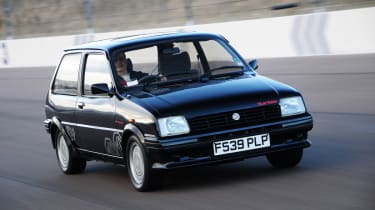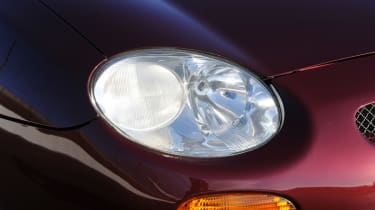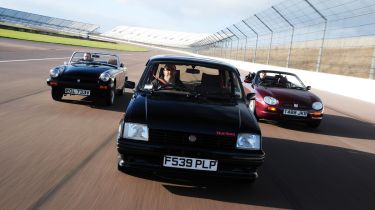1961-2002: MG TF, MG Metro Turbo and MG Midget
MG Midget 1961-79
Number produced: 224,843 Price new/now: £1,560/£2,000 Engine: 1.5-litre 4cyl, 65bhp 0-60mph/top speed: 12.3 secs/101mph
Despite its dinky dimensions, the MG Midget was a sales smash. Designed as an affordable entry-level model, the tiny two-seater combined eager performance, agile handling and wind-in-the-hair thrills with a low price and penny-pinching running costs.
The original launched in 1961, and was essentially a rebadged version of the Austin Healey Sprite. That meant a tiny 948cc four-cylinder engine, with 45bhp, a simple rear-wheel-drive layout and no-frills cabin – even a heater was an extra cost option.
A year after the launch, MG enlarged the engine to 1.1 litres and added disc brakes, while in 1966 the Midget got a detuned 65bhp version of the 1.3-litre A-Series engine from the Mini Cooper S.
The car then carried on virtually unchanged until 1974, when tough crash test regulations forced the company to carry out a major facelift. Engineers had to raise the low-slung ride height, while the dainty chrome bumpers were replaced by chunky black plastic items. Plus, under the bonnet, a new 1.5-litre engine was grafted in from the Triumph Spitfire.
This breathless engine was designed to meet strict US anti-pollution legislation. It was no more powerful than the old A-Series, but had more torque, and when combined with the 805kg kerbweight, it meant the car was nearly as fast as the bigger and more expensive MGB.
Used - available now

2023 Land Rover
Range Rover Evoque
16,327 milesAutomaticDiesel2.0L
Cash £24,920
2022 Peugeot
5008
3,424 milesAutomaticPetrol1.2L
Cash £26,199
2025 Volkswagen
Touran
16,670 milesAutomaticPetrol1.5L
Cash £22,513
2023 Vauxhall
Corsa
25,107 milesAutomaticPetrol1.2L
Cash £15,540Climb behind the wheel and you’ll find there’s a surprising amount of space. The Midget is also good to drive, with decent feedback from the steering and a precise gearshift. And although outright performance is modest, the compact dimensions mean it’s easy to keep your speed up in this car, especially on tight and twisty roads. In fact, after a few miles you can see why nearly 250,000 Midgets rolled out of the factory before production ended in 1979.
MG Metro 1982-90

Number produced: 142,165 Price new/now: £4,799/£2,500 Engine: 1.3-litre 4cyl, 72bhp (in 1300; Turbo had 93bhp) 0-60mph/top speed: 9.9 seconds/112mph (Turbo)
With the demise of the MGB and Midget at the end of the seventies and the closure of MG’s Abingdon plant in 1980, the brand needed reviving. The rise of the hot hatch gave Austin Rover the perfect excuse to indulge in badge engineering for its Metro, Maestro and Montego.
The first model to arrive was the MG Metro 1300. It used a tuned 1,275cc A-Series engine from the original Mini, and while it wasn’t the fastest hot hatch around, it stood out with racy stripes and alloys, plus it had servo-assisted four-piston front brakes as standard.
Six months after the 1300 was launched, the Metro Turbo arrived. It added a Garrett turbocharger, while Lotus worked its magic to produce a heady 93bhp – pretty good for an engine that could trace its roots all the way back to 1951!
Unfortunately, the four-speed box was just as ancient, and couldn’t handle all this power, so a special air intake tweak regulated turbo boost. Keep below 3,000rpm, and there’s light turbo pressure, with full boost only coming in above 4,000rpm, although by today’s standards the only sensation you get of acceleration is a whoosh from the turbo.
Gearbox failures were still common, while the Metro was plagued by rust. Plus, Mini owners cannibalised the turbo engine for their own cars – so the Metro Turbo is now far rarer than the sports cars that preceded it, with only around 20 still registered in the UK.
MGF 1995-2002

Number produced: 77,269 Price new/now: £17,540/£2,000 Engines: 1.6-litre 4cyl, 111bhp; 1.8-litre 4cyl, 158bhp 0-60mph: 9.7 secs; 6.9 secs Top speed: 115mph; 137mph
By the early nineties, Austin had become Rover, and bosses had ditched MG performance versions of the company’s hatchbacks to concentrate on developing the new models they hoped would revive its fortunes. But they’d seen the popularity of the Mazda MX-5 roadster – itself inspired by the MGB – and decided that a new MG-badged two-seater sports car was needed.
The MGB-based RV8 had been an interim solution while this all-new model was readied. And when the wraps came off the MGF late in 1995, it caused a major stir: not only was it the first all-new MG since the MGB, but it was also the first car from the brand to have a mid-engined, rear-wheel-drive layout.
Rounded styling meant it was impossible to mistake the MGF for anything other than an MG, while Rover’s revolutionary K Series engine gave the car enough power to compete with the MX-5. That mid-engined layout delivered entertaining handling, too, although the Hydragas suspension – derived from the set-up in the Metro – was ditched when the first facelift came around.
The MGF, and the TF that followed, continued in production throughout MG Rover’s turbulent life, until the company’s demise in 2005. Then, in 2008, the TF returned as the first UK model from Chinese-owned MG Motors. By then, the car was a generation behind its rivals, but it was the start of a new era for MG in the UK.







